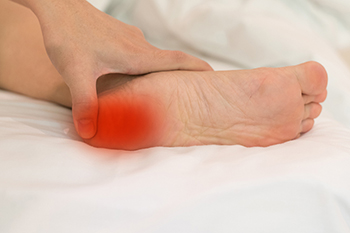Children, Young Teenagers, and Sever’s Disease
Tuesday, 12 July 2022 00:00
There is a growth plate in the heel of the foot that is known as the calcaneal apophysis. This is the area that connects the Achilles tendon and the plantar fascia to the heel. The foot condition that is known as Sever’s disease occurs as a result of excess tension on the Achilles tendon, or possibly from an injury to the heel. This generally affects children and young teenagers who participate in sporting activities. Common symptoms can include gradual heel pain, and many patients describe it as feeling like a bruise. Pain may be felt in the heel area only. Sever’s disease often develops from participating in high-impact sports such as basketball, football, or baseball. To confirm a diagnosis of Sever’s disease, a physical exam will be performed, and occasionally, an X-ray may be ordered to determine how advanced the growth plate is, in addition to observing if a stress fracture has occurred. Relief begins with temporarily stopping the activity that caused the condition, and performing specific heel stretches, which may ease the pain. If your child is affected by Sever’s disease, it is advised that a podiatrist be contacted who can begin the correct treatment process.
Sever's disease often occurs in children and teens. If your child is experiencing foot or ankle pain, see Dr. Scott Shrem from Garden State Foot & Ankle Center. Our doctor can treat your child’s foot and ankle needs.
Sever’s Disease
Sever’s disease is also known as calcaneal apophysitis, which is a medical condition that causes heel pain I none or both feet. The disease is known to affect children between the ages of 8 and 14.
Sever’s disease occurs when part of the child’s heel known as the growth plate (calcaneal epiphysis) is attached to the Achilles tendon. This area can suffer injury when the muscles and tendons of the growing foot do not keep pace with bone growth. Therefore, the constant pain which one experiences at the back of the heel will make the child unable to put any weight on the heel. The child is then forced to walk on their toes.
Symptoms
Acute pain – Pain associated with Sever’s disease is usually felt in the heel when the child engages in physical activity such as walking, jumping and or running.
Highly active – Children who are very active are among the most susceptible in experiencing Sever’s disease, because of the stress and tension placed on their feet.
If you have any questions, please feel free to contact our office located in Hazlet, NJ . We offer the newest diagnostic and treatment technologies for all your foot and ankle injuries.
Blog Archives
- April 2025
- March 2025
- February 2025
- January 2025
- December 2024
- November 2024
- October 2024
- September 2024
- August 2024
- July 2024
- June 2024
- May 2024
- April 2024
- March 2024
- February 2024
- January 2024
- December 2023
- November 2023
- October 2023
- September 2023
- August 2023
- July 2023
- June 2023
- May 2023
- April 2023
- March 2023
- February 2023
- January 2023
- December 2022
- November 2022
- October 2022
- September 2022
- August 2022
- July 2022
- June 2022
- May 2022
- April 2022
- March 2022
- February 2022
- January 2022
- December 2021
- November 2021
- October 2021
- September 2021
- August 2021
- July 2021
- June 2021
- May 2021
- April 2021
- March 2021
- February 2021
- January 2021
- December 2020
- November 2020
- October 2020
- September 2020
- August 2020
- July 2020
- June 2020
- May 2020
- April 2020
- March 2020
- February 2020
- January 2020
- December 2019
- November 2019
- October 2019
- September 2019
- August 2019
- July 2019
- June 2019
- May 2019
- April 2019
- March 2019
- February 2019
- January 2019
- December 2018
- November 2018
- October 2018
- September 2018
- August 2018
- July 2018
- June 2018
- May 2018
- April 2018
- March 2018








